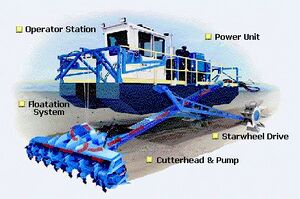Wet Dredging: Difference between revisions
No edit summary |
No edit summary |
||
| Line 3: | Line 3: | ||
The benefit of wet dredging is it can remove large amounts of localized sediment quickly with out removing the water in the [[Canal]]. A disadvantage is the inability to quantify whether enough of the contracted sediment was removed.<ref>Dredging Methods, http://www.aquamogmidwest.com/Contemporary_Dredging_Metho.html</ref> Also, this method of dredging is only able to remove sediment from the central area of a [[Canal]] in order to avoid damage to the [[Canal Wall]].<ref>Venice: Preservation and urban maintenance (pamphlet), Insula spa, Grafiche Veneziane.</ref> | The benefit of wet dredging is it can remove large amounts of localized sediment quickly with out removing the water in the [[Canal]]. A disadvantage is the inability to quantify whether enough of the contracted sediment was removed.<ref>Dredging Methods, http://www.aquamogmidwest.com/Contemporary_Dredging_Metho.html</ref> Also, this method of dredging is only able to remove sediment from the central area of a [[Canal]] in order to avoid damage to the [[Canal Wall]].<ref>Venice: Preservation and urban maintenance (pamphlet), Insula spa, Grafiche Veneziane.</ref> | ||
== See Also == | == See Also == | ||
| Line 12: | Line 10: | ||
== References == | == References == | ||
<references/> | <references/> | ||
[[Category:Canal Maintenance]] | |||
Revision as of 22:16, 6 December 2012

Wet dredging is a dredging process done with out removing the water from a Canal segment. This process is performed with a dredge boat and an attached hydraulic shovel. The boat simply drives to the location of sediment build up in the Canal and the hydraulic shovel removes the silt and discharges it to a sealed container on the boat. The collected silt is then disposed of.
The benefit of wet dredging is it can remove large amounts of localized sediment quickly with out removing the water in the Canal. A disadvantage is the inability to quantify whether enough of the contracted sediment was removed.[1] Also, this method of dredging is only able to remove sediment from the central area of a Canal in order to avoid damage to the Canal Wall.[2]
See Also
References
- ↑ Dredging Methods, http://www.aquamogmidwest.com/Contemporary_Dredging_Metho.html
- ↑ Venice: Preservation and urban maintenance (pamphlet), Insula spa, Grafiche Veneziane.